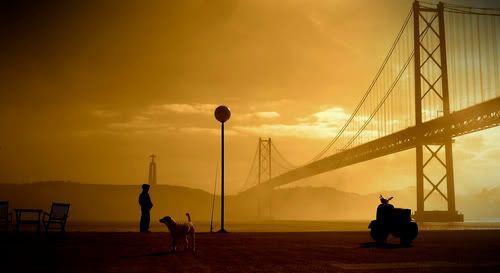Read also
Saturday, October 30, 2010
A film that it was dropped into the London Film Festival at the last moment.
Read also
LISBON STORY
From Wim Wenders website:
http://www.wim-wenders.com/movies/movies_spec/lisbonstory/lisbon_story.htm
"Dear Phil, I cannot continue m.o.s.! -- S.O.S.! -- Come to Lisbon with all your stuff a.s.a.p.! Big hug, Fritz."
Who is who? And what do all those abbreviations mean? The SOS of course, is obvious, and a.s.a.p. only strengthens the urgency: come AS SOON AS POSSIBLE. But m.o.s.?
Only if you work in movies you might know that M.O.S. is an old and rather strange word for "silent," and that the expression came up in the late twenties meaning "mit-out sound."
Anyway, we soon understand that the postcard was sent by a film director, Friedrich Monroe, to his friend Phillip Winter, a sound engineer. Friedrich has started a movie in Lisbon on a very romantic notion -- he wanted to do it "as if the whole history of cinema hadn't happened, shooting all on his own, a man alone in the streets, with an old hand-cranking camera, just like Buster Keaton in THE CAMERAMAN."
Well, Friedrich failed, and when he realized he had painted himself into a corner, he called Winter for help, hoping "that your microphones could pull my images out of their darkness, that sound could save the day."
LISBON STORY
1994
Storyline
Storyline
The director Friedrich Monroe has trouble with finishing a silent b&w movie about Lisbon. He calls his friend, the sound engineer Phillip Winter, for help. As Winter arrives Lisbon weeks later, Monroe is disappeared but has left the unfinished film. Winter decides to stay, because he is fascinated of the city and the Portuguese singer Teresa, and he starts to record the sound of the film. At the same time Monroe cruises through the city with a camcorder and tries to catch unseen pictures. Later they meet and Winter convinces Monroe of finishing the film. Written by Christoph Blendinger
Director:
Wim Wenders
Screenplay:
Wim Wenders
Director of Photography:
Lisa Rinzler
Editor:
Peter Przygodda
Musical Score:
Jürgen Knieper
Music:
Madredeus
Production Design: Zé Branco
Cast:
Rüdiger Vogler Patrick Bauchau Teresa Salgueiro and Madredeus
Guest Appearance: Manoel de Oliveira
Producers:
Ulrich Felsberg, Paulo Branco
Production:
Road Movies Filmproduktion/Berlin
Length: 100 min. Format: 35mm Colour
TRIVIA /IMDB
"Ah não ser eu toda a gente e toda a parte!". This phrase (roughly translated as "Would I be everybody and everywhere!"), written in one of the walls of the house where Winter's staying, is the last verse of "Ode Triunfal", a poem by Álvaro de Campos, one of the three main heteronyms of Portuguese poet Fernando Pessoa.
Monday, October 25, 2010
Do YOU KNOW ?????
Do you know that he've written/directed/edited this wonderful short film ?
Do you know that he is a great music composer ?
http://soundcloud.com/jbeat17
TC;FS - When Bodies Memorise Each Other (Interlude) by Josh Beattie
Do you know that he and his friends have a production company ?
Do YOU know that YOU have to ENCOURAGE Josh's generation ?
DO YOU know that THEY ARE THE FUTURE ?
"Cause you know what… I’m not doing well… life is actually pretty shit…" To Claire; From Sonny ...
“I totally saw the ending coming, but I still cried like a baby. Very good short film, might be taken off YouTube soon so watch quick!”
http://catieisel.tumblr.com/
via
http://fuckyeahfilmmaking.tumblr.com/
To Claire; From Sonny
Written/Directed/Edited by Josh Beattie
DoP & Cinematography: Shuwei Zhang
Starring Henry Orr as Sonny
Emmie Seaton as Claire
Gianna Gillies as Jess
Music composed by Josh Beattie
"If I Knew (Claire's Theme)" performed by
The Indooroopilly State Primary School Senior Choir
conducted by Margaret Hoey
"Let There Be Light (Main Theme)" performed by
Max Fowler-Roy (bass)
India Ghariss (cello)
Oscar Jemmot (viola)
Shuwei Zhang (violin)
Josh Beattie (brass and percussion)
Saturday, October 23, 2010
WATER CITY
EXPO Water city from martin de thurah on Vimeo.
Director Martin de Thurah
Dop Kasper Tuxen, Martin de Thurah
Edit Adam Nielsen
Producer Malene Dyhring / Bacon
Part of the Danish pavillion
EXPO Shanghai 2010
Rebooting Business and the World
At LSE "he talk “Rebooting Business and the World” argued that many established institutions have become atrophied because of the global financial crisis but that a new open network model built around collaborative technologies available through the web provide incredible opportunities to address key challenges in the environment, transport, government, education and health care."
You can read here a short brief of his talk written by Geoff Riley, formerly Head of Economics at Eton College and he is also co-Founder of Tutor2u.
The lecture has finished with a beautiful introduction of “Smart Swarm: Using Animal Behaviour to Organise Our World”.
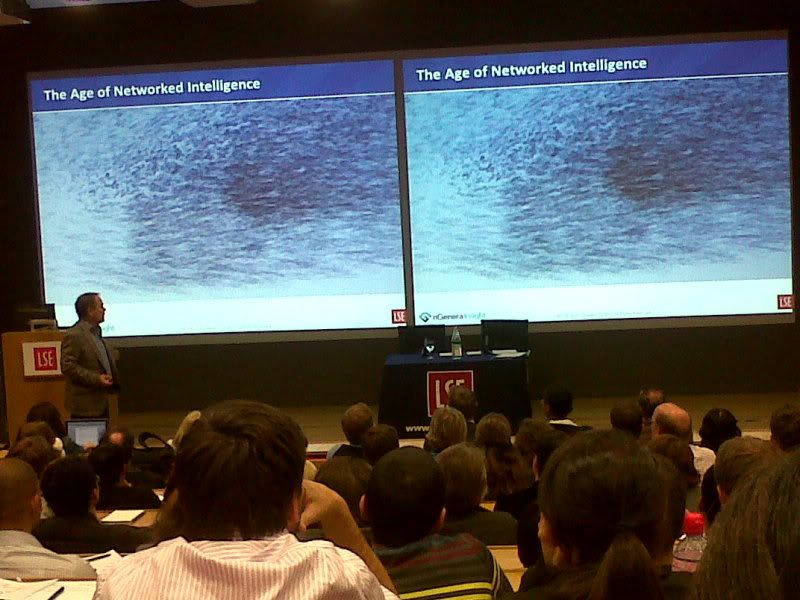
Also listen The Economics of Mass Collaboration (HBR Podcast) http://blogs.hbr.org/ideacast/2010/10/the-economics-of-mass-collabor.html
BusinessWeek special report on Macrowikinomics, Don Tapscott's latest book written with Anthony D. William.
http://www.businessweek.com/managing/special_reports/20101022_macrowikinomics.htm
Many thanks to Don Tapscott for invite. He is a genuine pioneer, as Lucian Tarnowski describes him ;)
You can’t make great movies if the world doesn’t amaze you.

The greatest special effect is the close-up. Every vista pales in comparison with the human face. Because without that face – what do you connect with? What moves you? The desert might be a character in Lawrence of Arabia, but its performance is opaque. What makes Lawrence is Peter O’Toole. The same way – in Apocalypse Now – Marlon Brandon shows you what the jungle is thinking. In director Tarsem Singh’s breathtaking movie, The Fall, there are sights that equal anything David Lean or Francis Ford Coppola accomplished. And there is also a little girl (Catinca Untaru), whose face knocks every other wonder into a cocked hat.
The story is about a stuntman in Hollywood in the 1920s. He has fallen, both literally and metaphorically (the movie – while breathtaking – isn’t subtle). He’s in hospital. A famous actor has seduced the stuntman’s girl. Of all his injuries, this cuckolding is the worst. The stuntman becomes addicted to morphine. Bedridden, it’s hard for him to maintain a constant supply. He befriends a little girl (hospitalized after – you guessed it – a fall) as a ruse so she’ll steal morphine for him. In return for her help, the little girl keeps bugging the stuntman to tell her a story. He does – and it’s breathtaking – but as the story unfolds, the morphine takes over…
Tarsem Singh spent four years making The Fall. In eighteen countries. With his own money. And Catinca Untaru still steals the show. In interview, the director speaks of how he couldn’t have made the movie till he found the right girl. And he was right. When a movie is this dazzling, it needs reality. Untaru has never acted before. With luck, she will never act again. Not for Sophia Coppola-type reasons, but because: she’ll never be this good. Non-actors get one shot at a perfect performance. Then they become actors. There are reaction shots The Fall catches from Untaru that one actor in a million could replicate. Tarsem Singh’s best decision was to let this little girl dictate how every other actor behaves. When Lee Pace (the stuntman) is with her, you’re watching an actor unlearn acting. And be better for it. Because acting is play time. Would that every movie had the luxury of children playing children instead of “child actors”.
While spirituality might seem ham-fisted in Singh’s handling of it (“Are you trying to save my soul?” the stuntman asks, repeatedly), like Darren Aronofsky, the soul of his movie isn’t there in words, it’s grasped holistically, through the movie. To put it another way, The Fall would be about the soul if the stuntman and the little girl talked about cornflakes. Like a great song which leaps the boundaries of its form; the message isn’t the words, it’s the music.
It’s easy to wear-out a word like “breathtaking”. How good can it be? we long to sneer. But great movies come from a director’s childish awe at the world. You can’t make great movies if the world doesn’t amaze you. How else to explain the power of the close-up? To look at something so intently that – for a few seconds, a lifetime – it engulfs you. Human faces are the best kept secrets told by close-ups. Most of us still retain the capacity to be awed by a desert or an ocean. And the deserts and oceans of The Fall are awe-inspiring as any in movies. But that one little girl. We’d miss her. She and everyone else who’s ever given a great performance on-screen. Because great acting is only half of it. For the other half: you have to look close.
I am an English teacher by day, and I’m often fairly busy, but a friend kept bugging me to write and so write I did (let that be a lesson to anyone who ever had a dream for someone else).
As far as intentions for the site go, I intend to write about movies I have seen. Some of them will be new releases, some of them will be old favourites and some of them I’ll review because my friend asks me to (I’ll bet he has plans). These reviews will not be fact-checked and will often, doubtless, contain inaccuracies and things I’ve remembered wrong. But they will also, hopefully, contain some thoughts you may agree with, and they will be written carefully, with care for the movies as much as where the commas should go.
If this site were a cinema it would be a small one, with only sort-of comfortable seating. It’s a pre-multiplex site: you come for the movies.
About MovieWaffle in 2010
The closest I ever came to getting shot was in Florida.
It was summer, and I had an AK47 pointed at my feet. The gun wasn’t mine, but it was my finger on the trigger. I had been handed a machine gun by a friend – partly for fun, partly to test my masculinity – and now, with a paper target taunting me like a raised middle finger, I was aiming low, in order not to lose control of the gun and kill everybody.
AK47s are lighter than you expect. They’re nearer the weight of an empty body bag, rather than a full one. However, far from being emboldened by the unexpected lightness of my gun, I was convinced that, when I pulled the trigger, the bastard thing would leap for my chin like a dog with iron teeth. So I pointed it down, as if ordering: “Sit”.
I was already nervous, after being told that I could burn my hand if I touched the barrel after firing. But the image of me, post-massacre, breaking my chin with the murder weapon…was too much.
I paused. There was something at stake beyond hitting the target. If I handed the gun back, I’d be coward. Not in the he-left-his-buddies-in-a-firefight sense; not even because I feared killing everybody, but because I’d have avoided risk.
Pulling that trigger was necessary to my life.
I gripped the gun, asserting control. My arms were rigid. The paper target was twenty feet away, but I wasn’t aiming for it. My aim was to fire. I willed my toes safe. I willed my friends safe. I willed the witless, molten AK not to catapult into my chin.
I fired…
(This is pretty much how I’d describe reviewing)
Thursday, October 21, 2010
Mass Observation Archive
I could stay there for years :)
Wednesday, October 20, 2010
JOÃO MAGUEIJO’S BIG BANG
You can watch the other 4 parts on youtube.
Cosmologist João Magueijo has tried to make sense of the universe for the past 20 years. For his efforts he has been called an anarchist, a heretic, a radical and even a moron.
In JOÃO MAGUEIJO’S BIG BANG the controversial theoretical physicist explains the Big Bang theory, the Horizon Problem and his controversial idea that the speed of light is variable.
But, if he's right, he'll undermine hundreds of years of ideas and research including Einstein’s iconic E=mc2.
Executive Producer Graham Booth
Tigress Productions for Science Channel
Joao Magueijo

Was Einstein Wrong?
http://discovermagazine.com/2003/apr/cover
Tuesday, October 19, 2010
TRIANGLE
Curator Jens Karlson asked me to make a short animation and get Robert Knoke's black and white artwork as base for video. I chosed to create tense harmony between geometrical forms and organic movements. Combustion helped me to expand possibilites of Black material with his strong music and sound design
TRI▲NGLE from Onur Senturk on Vimeo.
Trailer for Gus Van Sant’s RESTLESS
Description: The story of a terminally ill teenage girl (Wasikowska) who falls for a boy (Hopper) who likes to attend funerals and their encounters with the ghost of a Japanese kamikaze pilot from WWII (Kase).
“From Imagine Entertainment comes a powerful and emotional coming of age story, a remarkable film told with honesty and originality that will leave audiences moved. In the film, two outsiders, both shaped by the circumstances that have brought them together, forge a deep and lasting love. Directed by Gus Van Sant, one of the most astute observers of people living life on the edge, comes a take on friendship and young love as engaging and true as it is provocative and stirring.”
Rabindranath Tagore and a new business model of film
Where knowledge is free;
Where the world has not been broken up
into fragments by narrow domestic walls;
Where words come out from the depth of truth;
Where tireless striving stretches its arms towards perfection;
Where the clear stream of reason
has not lost its way into the dreary desert sand of dead habit;
Where the mind is led forward by thee into ever-widening thought and action -
Into that heaven of freedom, my Father, let my country awake."
From the English Gitanjali by Rabindranath Tagore (1912), the main work for which he won the Nobel Prize for Literature in 1913.
Apparently you will not find any link between this wonderful piece of poetry written by Rabindranath Tagore , the first non-European to win the Nobel Prize in Literature, and a new business model of film.
But if you will read about "The Shyama model - A commercially viable film business model based on Free and Creative Commons licensing" you will understand how Obhi Chatterjeen was inspired by the spirit of Tagore in creating a new way of financing movies.
Plus The Hollywood Reporter's note : 'Shyama' gets fresh distribution spin / Dance musical available at users' preferred price
And also don't forget to watch another indian free story :)
Sita Sings the Blues
"Sita" had its premiere at Berlin in February 2008, where it won a Silver Bear, and had its U.S. premiere at the Tribeca Film Festival in April 2009.
Monday, October 18, 2010
Limit To Your Love
James Blake - Limit To Your Love from James Blake on Vimeo.
Video for James Blake's track 'Limit To Your Love'. Directed by Martin de Thurah
Released on 8 November
4 Months, 3 Weeks and 2 Days
A digital filmmaker’s map to the web
20+ sites every digital filmmaker should know
http://youtube-global.blogspot.com/2010/10/digital-filmmakers-map-to-web.html
Sites to help you....
be in the know
distribute
connect
learn new tricks
make some money
compete
A portuguese sense and sensibility: MOMENTOS
As a personal note, the casting is perfect.
"It actually reminded me a lot of a beautiful short animation called "Father and Daughter," by Michael Dudock de Witt, which won an Oscar about a decade ago and deals with a similar theme" Paxson Woelber
STORYLINE
An homeless man sleeps in front of an empty store when suddenly a vehicle stops and two men start to carry cases inside. Meanwhile the man tries to understand what is going on.
ALWAYS WATCH FULL SCREEN !
MAKING OF
Saturday, October 16, 2010
I love EVERYNONE
Made by Everynone (in Collaboration with WNYC's Radiolab & NPR)
Directed by Daniel Mercadante & Will Hoffman
Supervising Producer: Robert Krulwich
Original Score: Keith Kenniff (unseen-music.com)
everynone.com
"The internet is the most powerful potential source of enlightenment ever created."
Almost four in five people around the world believe that access to the internet is a fundamental right, a poll for the BBC World Service suggests.
The survey - of more than 27,000 adults across 26 countries - found strong support for net access on both sides of the digital divide.
The findings in detail [477 KB]
We are the people of the internet ....
STAY HUMAN, STAY AWAKE, STAY GOOD
Probably here in the binary world I have the unlimited power and the freedom to connect worlds, stories and moments of life that have nothing in common.
Here I see one single tragic story about ourselves. I see a woman dying and a choir of blind angels singing. I am watching both videos in the same time. One is silent and one has music. I recommend you to watch them in the same way...
We preach the online communion of intelligence and emotion, but we are incapable to experience the real communion in the real life. We are the creators of the unlimited social networks , but we are living in a such disconnected world. We are developing fabulous technologies to fly in space and to read our minds, but we know so little about our souls.
What we want to achieve ? Where we want to go ? How we define a human value ? How we define ourselves ?
"Maricica Hahaianu was taken off life support and pronounced dead"
32 year old Maricica Hahaianu got into an argument with an Italian over a ticket in Anagnina metro station. She hit her head when she fell to the ground after the 20 year old aggressor punched her. A video shows her lying on the floor for a long time as no one in the metro station intervened to help her.
masakepic , Brighton, England
I'm amazed people ignored it completely, in broad daylight, especially when she didn't get up. Not everyone is like that. / ajnabee equally sad was/is the total indifference to it by the part of bystanders, the government, and the public in general.
Eric Whitacre put together a choir of 185 singers from 12 countries who never sang together until their voices were edited together. Here they perform Whitacre’s composition Lux Aurumque.
via Sorin Grumazescu
In the end, I will kindly ask you to stay HUMAN, to stay AWAKE, to stay GOOD.
We have Time by Octavian Paler
We have time
we have time for all.
To sleep,
to jog right and left
to regret our mistakes and make a mistake again
to judge others and we absolve ourselves
we have time to read and write
to correct what we wrote, to regret what we wrote
we have time to make plans and do not respect them
we have time to make illusions
and rummage through their ashes later
we have time for ambitions and diseases
to blame destiny and details
we have time to watch the clouds, advertisements or some accident
we have time to get away questions
to postpone the answers
we have time to crush a dream and reinvent it
we have time to make friends and lose them
we have time to take lessons and then forget them
we have time to receive gifts and not understand them
we have time for all
Is no time for a little tenderness
and when to do it, we die.
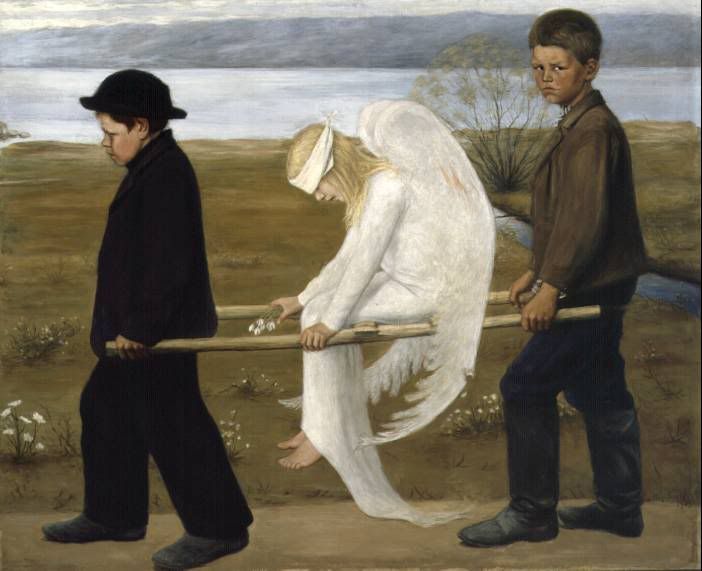
The Wounded Angel (Finnish: Haavoittunut enkeli) (1903) is a painting by Finnish symbolist painter Hugo Simberg
'SixthSense' is a wearable gestural interface that augments the physical world around us with digital information and lets us use natural hand gesture
That's all. Thank you."
Pranav Mistry
Many thanks to Obhi for this post.
Friday, October 15, 2010
33 men on 13.10.10
33 men rescued on 13.10.10 >> 13+10+10= 33
ENJOY THE REAL BEAUTY OF LIFE
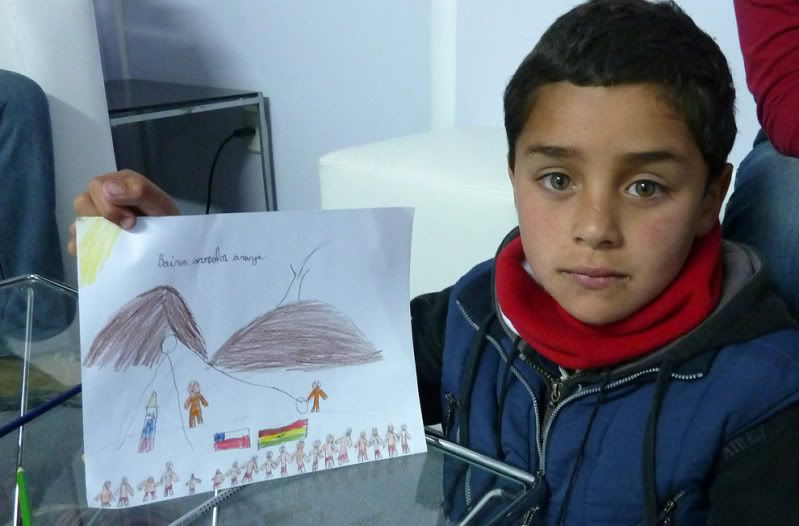
The son of Chilean miner Florencio Avalos, seven-year-old Bairon, shows a drawing depicting the rescue of his father, as he is examined by doctors after being brought to the surface on October 13, 2010. (ARIEL MARINKOVIC/AFP/Getty Images) #
A STORY IN PICTURE (49 photos)
http://www.boston.com/bigpicture/2010/10/rescued_from_a_chilean_mine.html
Rescued from a Chilean mine
Over two months have passed since the August 5th collapse of the San Jose mine near Copiapo, Chile, when 33 miners were trapped 700 meters (2,300 ft) below ground. The men were kept alive over that time by supplies delivered through narrow holes drilled down to them, and kept hope through video conferences with family - until last night, when the first of the 33 miners was successfully lifted to the surface in a specially-designed rescue capsule. Friends and relatives, many of whom had camped nearby for months, slowly let their cautious optimism become joy as they were reunited with their loved ones. As of this writing, at 9:30 pm, Eastern time, all of the 33 men have now made it safely to the surface.
All of these peoples teach us that there are other ways of being, other ways of thinking, other ways of orienting yourself in the Earth.
TRANSCRIPT
You know, one of the intense pleasures of travel and one of the delights of ethnographic research is the opportunity to live amongst those who have not forgotten the old ways, who still feel their past in the wind, touch it in stones polished by rain, taste it in the bitter leaves of plants. Just to know that Jaguar shamans still journey beyond the Milky Way, or the myths of the Inuit elders still resonate with meaning, or that in the Himalaya, the Buddhists still pursue the breath of the Dharma, is to really remember the central revelation of anthropology, and that is the idea that the world in which we live in does not exist in some absolute sense, but is just one model of reality, the consequence of one particular set of adaptive choices that our lineage made, albeit successfully, many generations ago.
And of course, we all share the same adaptive imperatives. We're all born. We all bring our children into the world. We go through initiation rites. We have to deal with the inexorable separation of death, so it shouldn't surprise us that we all sing, we all dance, we all have art.
But what's interesting is the unique cadence of the song, the rhythm of the dance in every culture. And whether it is the Penan in the forests of Borneo, or the Voodoo acolytes in Haiti, or the warriors in the Kaisut desert of Northern Kenya, the Curandero in the mountains of the Andes, or a caravanserai in the middle of the Sahara. This is incidentally the fellow that I travelled into the desert with a month ago, or indeed a yak herder in the slopes of Qomolangma, Everest, the goddess mother of the world.
All of these peoples teach us that there are other ways of being, other ways of thinking, other ways of orienting yourself in the Earth. And this is an idea, if you think about it, can only fill you with hope. Now, together the myriad cultures of the world make up a web of spiritual life and cultural life that envelops the planet, and is as important to the well-being of the planet as indeed is the biological web of life that you know as a biosphere. And you might think of this cultural web of life as being an ethnosphere and you might define the ethnosphere as being the sum total of all thoughts and dreams, myths, ideas, inspirations, intuitions brought into being by the human imagination since the dawn of consciousness. The ethnosphere is humanity's great legacy. It's the symbol of all that we are and all that we can be as an astonishingly inquisitive species.
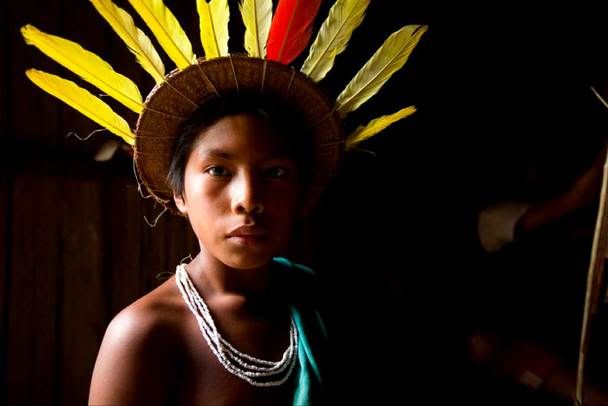
And just as the biosphere has been severely eroded, so too is the ethnosphere -- and if anything at a far greater rate. No biologists, for example, would dare suggest that 50 percent of all species or more have been or are on the brink of extinction because it simply is not true, and yet that -- the most apocalyptic scenario in the realm of biological diversity -- scarcely approaches what we know to be the most optimistic scenario in the realm of cultural diversity. And the great indicator of that, of course, is language loss.
When each of you in this room were born, there were 6,000 languages spoken on the planet. Now, a language is not just a body of vocabulary or a set of grammatical rules. A language is a flash of the human spirit. It's a vehicle through which the soul of each particular culture comes into the material world. Every language is an old-growth forest of the mind, a watershed, a thought, an ecosystem of spiritual possibilities.
And of those 6,000 languages, as we sit here today in Monterey, fully half are no longer being whispered into the ears of children. They're no longer being taught to babies, which means, effectively, unless something changes, they're already dead. What could be more lonely than to be enveloped in silence, to be the last of your people to speak your language, to have no way to pass on the wisdom of the ancestors or anticipate the promise of the children? And yet, that dreadful fate is indeed the plight of somebody somewhere on Earth roughly every two weeks, because every two weeks, some elder dies and carries with him into the grave the last syllables of an ancient tongue.
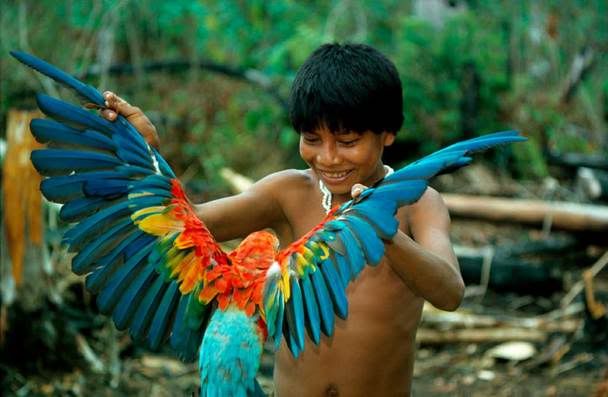
And I know there's some of you who say, "Well, wouldn't it be better? Wouldn't the world be a better place if we all just spoke one language?" And I say, "Great, let's make that language Yoruba. Let's make it Cantonese. Let's make it Kogi." And you'll suddenly discover what it would be like to be unable to speak your own language.
And so, what I'd like to do with you today is sort of take you on a journey through the ethnosphere -- a brief journey through the ethnosphere to try to begin to give you a sense of what in fact is being lost. Now, there are many of us who sort of forget that when I say "different ways of being," I really do mean different ways of being.
Take, for example, this child of Barasana in Northwest Amazon, the people of the anaconda who believe that mythologically they came up the milk river from the east in the belly of sacred snakes. Now, this is a people who cognitively do not distinguish the color blue from the color green because the canopy of the heavens is equated to the canopy of the forest upon which the people depend. They have a curious language and marriage rule which is called linguistic exogamy: you must marry someone who speaks a different language. And this is all rooted in the mythological past, yet the curious thing is in these long houses where there are six or seven languages spoken because of intermarriage, you never hear anyone practicing a language. They simply listen and then begin to speak.
Or, one of the most fascinating tribes I ever lived with, the Waorani of northeastern Ecuador, an astonishing people first contacted peacefully in 1958. In 1957, five missionaries attempted contact and made a critical mistake. They dropped from the air eight by ten glossy photographs of themselves in what we would say to be friendly gestures, forgetting that these people of the rainforest had never seen anything two-dimensional in their lives. They picked up these photographs from the forest floor, tried to look behind the face to find the form or the figure, found nothing, and concluded that these were calling cards from the devil, so they speared the five missionaries to death. But the Waorani didn't just spear outsiders. They speared each other. 54 percent of their mortality was due to them spearing each other. We traced genealogies back eight generations, and we found two instances of natural death and when we pressured the people a little bit about it, they admitted that one of the fellows had gotten so old that he died getting old, so we speared him anyway. (Laughter) But at the same time they had a perspicacious knowledge of the forest that was astonishing. Their hunters could smell animal urine at 40 paces and tell you what species left it behind.
In the early '80s, I had a really astonishing assignment when I was asked by my professor at Harvard if I was interested in going down to Haiti, infiltrating the secret societies which were the foundation Duvalier's strength and Tonton Macoutes, and securing the poison used to make zombies. In order to make sense out of sensation of course, I had to understand something about this remarkable faith of Vodoun, and Voodoo is not a black magic cult. On the contrary, it's a complex metaphysical worldview. It's interesting. If I asked you to name the great religions of the world, what would you say? Christianity, Islam, Buddhism, Judaism, whatever.
There's always one continent left out, the assumption being that sub-Saharan Africa had no religious beliefs. Well, of course, they did and Voodoo is simply the distillation of these very profound religious ideas that came over during the tragic Diaspora of the slavery era. But, what makes Voodoo so interesting is that it's this living relationship between the living and the dead. So, the living give birth to the spirits. The spirits can be invoked from beneath the Great Water, responding to the rhythm of the dance to momentarily displace the soul of the living, so that for that brief shining moment, the acolyte becomes the god. That's why the Voodooists like to say that "You white people go to church and speak about God. We dance in the temple and become God." And because you are possessed, you are taken by the spirit, how can you be harmed? So you see these astonishing demonstrations: Voodoo acolytes in a state of trance handling burning embers with impunity, a rather astonishing demonstration of the ability of the mind to affect the body that bears it when catalyzed in the state of extreme excitation.
Now, of all the peoples that I've ever been with, the most extraordinary are the Kogi of the Sierra Nevada de Santa Marta in northern Colombia. Descendants of the ancient Tairona civilization which once carpeted the Caribbean coastal plain of Colombia in the wake of the conquest, these people retreated into an isolated volcanic massif that soars above the Caribbean coastal plain. In a bloodstained continent, these people alone were never conquered by the Spanish. To this day, they remain ruled by a ritual priesthood but the training for the priesthood is rather extraordinary. The young acolytes are taken away from their families at the age of three and four, sequestered in a shadowy world of darkness in stone huts at the base of glaciers for 18 years. Two nine-year periods deliberately chosen to mimic the nine months of gestation they spend in their natural mother's womb, now they are metaphorically in the womb of the great mother. And for this entire time, they are inculturated into the values of their society, values that maintain the proposition that their prayers and their prayers alone maintain the cosmic -- or we might say the ecological -- balance. And at the end of this amazing initiation, one day they're suddenly taken out and for the first time in their lives, at the age of 18, they see a sunrise. And in that crystal moment of awareness of first light as the Sun begins to bathe the slopes of the stunningly beautiful landscape, suddenly everything they have learned in the abstract is affirmed in stunning glory. And the priest steps back and says, "You see? It's really as I've told you. It is that beautiful. It is yours to protect." They call themselves the elder brothers and they say we, who are the younger brothers, are the ones responsible for destroying the world.

Now, this level of intuition becomes very important. Whenever we think of indigenous people and landscape, we either invoke Rousseau and the old canard of the noble savage, which is an idea racist in its simplicity, or alternatively, we invoke Thoreau and say these people are closer to the Earth than we are. Well, indigenous people are neither sentimental nor weakened by nostalgia. There's not a lot of room for either in the malarial swamps of the Asmat or in the chilling winds of Tibet, but they have, nevertheless, through time and ritual, forged a traditional mystique of the Earth that is based not on the idea of being self-consciously close to it, but on a far subtler intuition: the idea that the Earth itself can only exist because it is breathed into being by human consciousness.
Now, what does that mean? It means that a young kid from the Andes who's raised to believe that that mountain is an Apu spirit that will direct his or her destiny will be a profoundly different human being and have a different relationship to that resource or that place than a young kid from Montana raised to believe that a mountain is a pile of rock ready to be mined. Whether it's the abode of a spirit or a pile of ore is irrelevant. What's interesting is the metaphor that defines the relationship between the individual and the natural world. I was raised in the forests of British Columbia to believe those forests existed to be cut. That made me a different human being than my friends among the Kwagiulth who believe that those forests were the abode of Huxwhukw and the Crooked Beak of Heaven and the cannibal spirits that dwelled at the north end of the world, spirits they would have to engage during their Hamatsa initiation.
Now, if you begin to look at the idea that these cultures could create different realities, you could begin to understand some of their extraordinary discoveries. Take this plant here. It's a photograph I took in the Northwest Amazon just last April. This is ayahuasca, which many of you have heard about, the most powerful psychoactive preparation of the shaman's repertoire. What makes ayahuasca fascinating is not the sheer pharmacological potential of this preparation, but the elaboration of it. It's made really of two different sources. On the one hand, there's this woody liana which has in it a series of beta-carbolines, harmine, harmaline, mildly hallucinogenic. To take the vine alone is rather to have sort of blue hazy smoke drift across your consciousness, but it's mixed with the leaves of a shrub in the coffee family called Psychotria viridis. This plant had in it some very powerful tryptamines, very close to brain serotonin, dimethyltryptamine, 5-methoxydimethyltryptamine. If you've ever seen the Yanomami blowing that snuff up their noses, that substance they make from a different set of species also contains methoxydimethyltryptamine. To have that powder blown up your nose is rather like being shot out of a rifle barrel lined with baroque paintings and landing on a sea of electricity. (Laughter) It doesn't create the distortion of reality; it creates the dissolution of reality.
In fact, I used to argue with my professor, Richard Evan Shultes -- who is a man who sparked the psychedelic era with his discovery of the magic mushrooms in Mexico in the 1930s. I used to argue that you couldn't classify these tryptamines as hallucinogenic because by the time you're under the effects there's no one home anymore to experience a hallucination. (Laughter)
But the thing about tryptamines is they cannot be taken orally because they're denatured by an enzyme found naturally in the human gut called monoamine oxidase. They can only be taken orally if taken in conjunction with some other chemical that denatures the MAO. Now, the fascinating things are that the beta-carbolines found within that liana are MAO inhibitors of the precise sort necessary to potentiate the tryptamine. So you ask yourself a question. How in a flora of 80,000 species of vascular plants, do these people find these two morphologically unrelated plants that when combined in this way, created a kind of biochemical version of the whole being greater than the sum of the parts?
Well, we use that great euphemism, trial and error, which is exposed to be meaningless. But you ask the Indians, and they say, "The plants talk to us."
Well, what does that mean? This tribe, the Cofan, has 17 varieties of ayahuasca, all of which they distinguish a great distance in the forest, all of which are referable to our eye as one species. And then you ask them how they establish their taxonomy and they say, "I thought you knew something about plants. I mean, don't you know anything?" And I said, "No." Well, it turns out you take each of the 17 varieties in the night of a full moon, and it sings to you in a different key. Now, that's not going to get you a Ph.D. at Harvard, but it's a lot more interesting than counting stamens.
Now, (Applause) the problem -- the problem is that even those of us sympathetic with the plight of indigenous people view them as quaint and colorful but somehow reduced to the margins of history as the real world, meaning our world, moves on. Well, the truth is the 20th century, 300 years from now, is not going to be remembered for its wars or its technological innovations, but rather as the era in which we stood by and either actively endorsed or passively accepted the massive destruction of both biological and cultural diversity on the planet. Now, the problem isn't change. All cultures through all time have constantly been engaged in a dance with new possibilities of life.
And the problem is not technology itself. The Sioux Indians did not stop being Sioux when they gave up the bow and arrow any more than an American stopped being an American when he gave up the horse and buggy. It's not change or technology that threatens the integrity of the ethnosphere. It is power. The crude face of domination. Where ever you look around the world, you discover that these are not cultures destined to fade away. These are dynamic living peoples being driven out of existence by identifiable forces that are beyond their capacity to adapt to. Whether it's the egregious deforestation in the homeland of the Penan -- a nomadic people from Southeast Asia, from Sarawak -- a people who lived free in the forest until a generation ago, and now have all been reduced to servitude and prostitution on the banks of the rivers, where you can see the river itself is soiled with the silt that seems to be carrying half of Borneo away to the South China Sea, where the Japanese freighters hang light in the horizon ready to fill their holds with raw logs ripped from the forest. Or in the case of the Yanomami, it's the disease entities that have come in, in the wake of the discovery of gold.
Or if we go into the mountains of Tibet, where I'm doing a lot of research recently, you'll see it's a crude face of political domination. You know, genocide, the physical extinction of a people is universally condemned, but ethnocide, the destruction of people's way of life, is not only not condemned, it's universally -- in many quarters -- celebrated as part of a development strategy. And you cannot understand the pain of Tibet until you move through it at the ground level. I once travelled 6,000 miles from Chengdu in Western China overland through southeastern Tibet to Lhasa with a young colleague, and it was only when I got to Lhasa that I understood the face behind the statistics you hear about. 6,000 sacred monuments torn apart to dust and ashes. 1.2 million people killed by the cadres during the Cultural Revolution. This young man's father had been ascribed to the Panchen Lama. That meant he was instantly killed at the time of the Chinese invasion. His uncle fled with his holiness in the Diaspora that took the people to Nepal. His mother was incarcerated for the price of -- for the crime of being wealthy. He was smuggled into the jail at the age of two to hide beneath her skirt tails because she couldn't bear to be without him. The sister who had done that brave deed was put into an education camp. One day she inadvertently stepped on an armband of Mao, and for that transgression, she was given seven years of hard labor. The pain of Tibet can be impossible to bear, but the redemptive spirit of the people is something to behold.
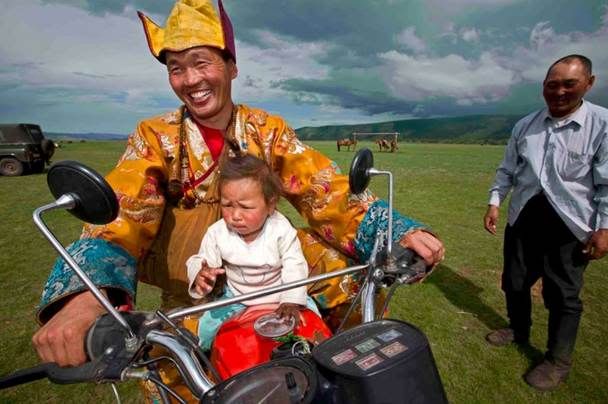
And in the end, then, it really comes down to a choice. Do we want to live in a monochromatic world of monotony or do we want to embrace a polychromatic world of diversity? Margaret Mead, the great anthropologist, said before she died that her greatest fear was that as we drifted towards this blandly amorphous generic world view not only would we see the entire range of the human imagination reduced to a more narrow modality of thought, but that we would wake from a dream one day having forgotten there were even other possibilities.
And it's humbling to remember that our species has, perhaps, been around for [150,000] years. The Neolithic Revolution -- which gave us agriculture, at which time we succumbed to the cult of the seed, the poetry of the shaman was displaced by the prose of the priesthood, we created hierarchy specialization surplus -- is only 10,000 years ago. The modern industrial world as we know it is barely 300 years old. Now, that shallow history doesn't suggest to me that we have all the answers for all of the challenges that will confront us in the ensuing millennia. When these myriad cultures of the world are asked the meaning of being human, they respond with 10,000 different voices.
And it's within that song that we will all rediscover the possibility of being what we are: a fully conscious species, fully aware of ensuring that all peoples and all gardens find a way to flourish. And there are great moments of optimism.
This is a photograph I took at the northern tip of Baffin Island when I went narwhal hunting with some Inuit people, and this man, Olayuk, told me a marvelous story of his grandfather. The Canadian government has not always been kind to the Inuit people, and during the 1950s, to establish our sovereignty, we forced them into settlements. This old man's grandfather refused to go. The family, fearful for his life, took away all of his weapons, all of his tools. Now, you must understand that the Inuit did not fear the cold; they took advantage of it. The runners of their sleds were originally made of fish wrapped in caribou hide. So, this man's grandfather was not intimidated by the Arctic night or the blizzard that was blowing. He simply slipped outside, pulled down his sealskin trousers and defecated into his hand. And as the feces began to freeze, he shaped it into the form of a blade. He put a spray of saliva on the edge of the shit knife and as it finally froze solid, he butchered a dog with it. He skinned the dog and improvised a harness, took the ribcage of the dog and improvised a sled, harnessed up an adjacent dog, and disappeared over the ice floes, shit knife in belt. Talk about getting by with nothing. (Laughter)
And this, in many ways, (Applause) is a symbol of the resilience of the Inuit people and of all indigenous people around the world. The Canadian government in April of 1999 gave back to total control of the Inuit an area of land larger than California and Texas put together. It's our new homeland. It's called Nunavut. It's an independent territory. They control all mineral resources. An amazing example of how a nation-state can reach -- seek restitution with its people.
And finally, in the end, I think it's pretty obvious at least to all of all us who've travelled in these remote reaches of the planet, to realize that they're not remote at all. They're homelands of somebody. They represent branches of the human imagination that go back to the dawn of time. And for all of us, the dreams of these children, like the dreams of our own children, become part of the naked geography of hope.
So, what we're trying to do at the National Geographic finally, is, we believe that politicians will never accomplish anything. We think that polemics -- (Applause) we think that polemics are not persuasive, but we think that storytelling can change the world, and so we are probably the best storytelling institution in the world. We get 35 million hits on our website every month. 156 nations carry our television channel. Our magazines are read by millions. And what we're doing is a series of journeys to the ethnosphere where we're going to take our audience to places of such cultural wonder that they cannot help but come away dazzled by what they have seen, and hopefully, therefore, embrace gradually, one by one, the central revelation of anthropology: that this world deserves to exist in a diverse way, that we can find a way to live in a truly multicultural pluralistic world where all of the wisdom of all peoples can contribute to our collective well-being.
Thank you very much
Last of Their Kind: What Is Lost When Cultures Die?
The world's cultures have been disappearing, taking valuable knowledge with them, but there is reason to hope From the September 2010 Scientific American Magazine
"The Buddhists of Tibet spend their life preparing for a moment that we spend most of our lives pretending does not exists:death" Wade Davis
Read more http://64.38.12.138/boardx/topic.asp?TOPIC_ID=41440
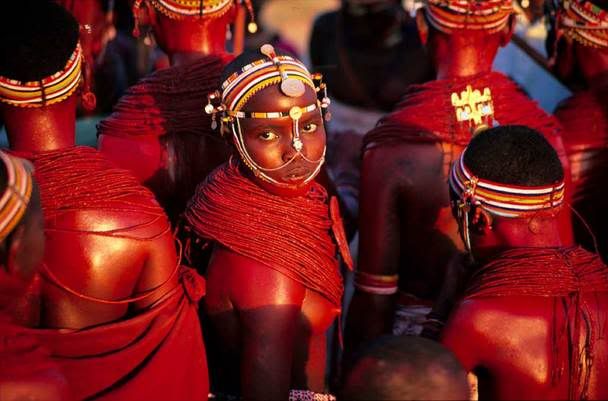
photographs by Wade Davis
Thursday, October 14, 2010
I'll be gone
Credits:
Music title: MARIO BASANOV & VIDIS feat JAZZU - I'll be gone
Director: Rimantas Lukavicius
CGI: Rimantas Lukavicius
Producers: Martynas Mickenas, Arunas Matacius
Production Company: RGB
Inspired by SOBIESKI
Year of completion: 2008
Single is available at:
http://www.junodownload.com/products/1495491-2.htm
One Day On Earth 10/10/10 @ Bordeaux (France)
How do you like this story ?
When I know your soul, I will paint your eyes.
It is hard to describe in words the emotion of such an encounter. They were all together - Picasso, Renoir, Monet, Matisse ...but Modigliani was the emblematic artist of this exhibition .
London Highlights of Sotheby’s autumn Evening Sale of Impressionist & Modern Art in New York on 2 November 2010

Nu assis sur un divan (La Belle Romaine)-A.Modigliani
"The cover lot of the Evening Sale catalogue is Nu assis sur un divan (La Belle Romaine), the finest painting by Amedeo Modigliani to appear on the market in years (est. in excess of $40 million)*. The work belongs to the artist’s most important series of nudes, all painted in 1917. While Modigliani began painting nudes in 1908, it was not until he abandoned his pursuit of sculpture in 1914 that he developed the unique style exemplified by La Belle Romaine. Modigliani evokes a voluptuous sensuality through his palette of amber and crimson tones, the model’s pose and the intimate setting. The work and artist both have a distinguished history at Sotheby’s. La Belle Romaine last appeared on the market in 1999, when it sold at Sotheby’s New York for $16.8 million, a world record price for any work by Modigliani at the time. More recently, Sotheby’s set the current record for a painting by Modigliani in 2004 with our sale of Jeanne Hébuterne (devant une porte) for $31.4 million."
ArtDaily
First I was confused. Most of the newsapers announced that the two paintings of Modigliani were exposed by Sotheby and Christie's in the same time.
After a visit at Christie's (my first one), I was a bit sad thinking that probably I will not see the painting of Jeanne - Jeanne Hébuterne au chapeau.
Then the surprize was sublime. Both paintings were at Sotheby's.
I stood speechless in front of Jeanne's picture... You can read her story in her eyes, although this is such an unusual characterstic of Modigliani's portaits. He often left the eyes of his portrait subjects blank. No windows for the souls.
'When I know your soul, I will paint your eyes.' Modigliani

If you are in London until October 15th and if you love art , don't miss Modigliani
and Sotheby's London Hilights of Impressionist & Modern Art Evening Sale in New York – 2 November 2010. Sotheby's London can be found in the heart of the West End on 34 New Bond Street, close to the corner with Conduit Street.
One last notice: Sotheby's moved into the galleries at 34-35 New Bond Street in 1917, exactly in the year when Modigliani painted Jeanne's portrait.
Tuesday, October 12, 2010
U2 & NASA , Touring the Space
U2 approached NASA with an idea to include a dialogue between themselves and the crew of the International Space Station in the U2 360 show. NASA astronauts spoke with U2 several times before recording a video segment that U2 incorporated into their concert.
Modigliani . The business model of life.
You will decide the meaning of my post, and the business model of your life.
'There hasn't been any art yet. Art is just beginning.' Constantin Brancusi. Romanian Sculptor. 1876 – 1957
"How much would you pay for planet Earth? " New Scientist, 12 October 2010
" Amedeo Modigliani, a painter and a sculptor, was born July 2, 1884, in Livorno, Italy. "
" He was wasting his talents as much as he wasted his money. He could never make enough money to live and was used to selling his drawings for only a few sous."
www.jewishvirtuallibrary.org/
2010
" A sculpted stone head by artist Amedeo Modigliani sold at Christie's in Paris on Monday for euro 43.18 million ($52.8 million), breaking the record for a work by the Italian artist, the auction house said. It was also the highest-priced work sold at an auction in France, Christie's said. An anonymous buyer bid for the piece by telephone. The piece, sculpted between 1910 and 1912, depicts an elongated head with almond-shaped eyes and flowing hair, and it is reminiscent of the artist's paintings. Modigliani, who lived from 1884 to 1920, originally focused on sculpture but switched to painting in part because of health problems. "
http://www.artknowledgenews.com/2010-06-15-00-28-16-world-record-price-for-a-modigliani-sculpture-sold-at-auction-at-christies-in-paris.html
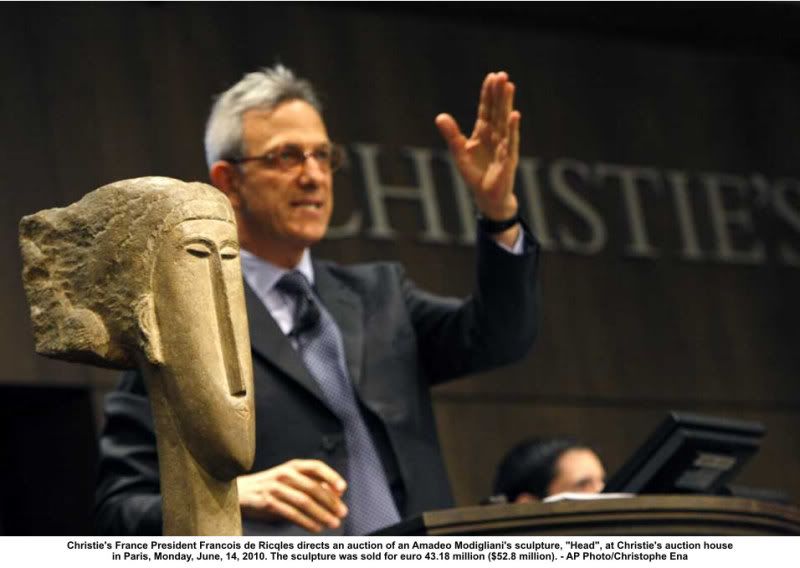
" Tête is notable as a compendium of the key sources that helped Modigliani to forge his distinctive style. Foremost among these influences was the sculptor Constantin Brancusi, whom Modigliani met through Dr. Paul Alexandre in 1909. Brancusi quickly became both friend and mentor to the young artist. In the present work, the simplification of form, emphasis on geometry and feeling for linear rhythm clearly reflect the Romanian artist’s influence, Brancusi. "
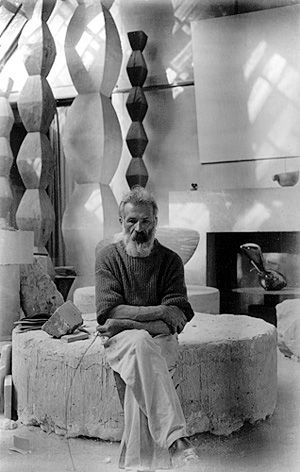
"Brâncuşi held a particular interest in mythology, especially Romanian mythology, folk tales, and traditional art (which also had a strong influence to his works), but he became interested in African and Mediterranean art as well."
http://www.christies.com/
His parents, Nicolae and Maria Brancusi, were poor peasants.
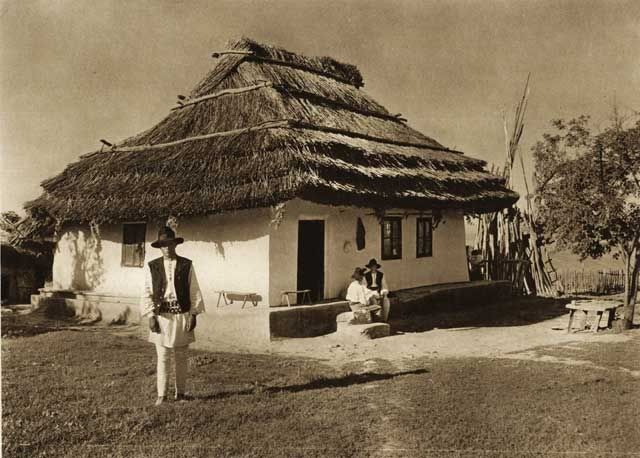
MASTERWORKS SOLD TO BENEFIT YOUNGARTS, THE CORE PROGRAM OF THE
NATIONAL FOUNDATION FOR ADVANCEMENT IN THE ARTS
(organization that recognizes and supports America’s most talented 17-18 year olds in the visual, literary and performing arts.)
http://www.artdaily.org/index.asp?int_sec=2&int_new=41701

"Jeanne Hébuterne, the shy student who would become painter and sculptor Amedeo Modigliani’s final muse, was born in Paris in April 1898."
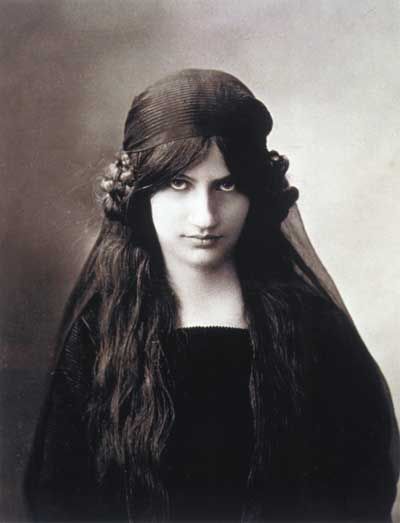
" Modigliani’s epitaph reads Struck Down By Death In the Moment of Glory and Jeanne’s reads Devoted Companion to The Extreme Sacrifice, but Jeanne Hébuterne was more than a martyr. She was a talented, almost ethereal young woman, strong enough to handle Modigliani’s passion and to ease his death, but just not strong enough to carry on without him"
http://www.suite101.com/content/jeanne-hbuterne-a22237#ixzz12BTmTtyH
Do you know what love is ?
"Art lovers will now have a unique opportunity to catch a glimpse of the works of two iconic 19th century artists -- Claude Monet and Amedeo Clemente Modigliani.Starting Monday, these spectacular works of art will be on display at Sotheby's London galleries till October 15.
Jeanne Hébuterne (au chapeau) by Modigliani is estimated at $9-12 million."
" Over half a billion pounds of modern and contemporary art is on view in London this week at Frieze and in the auction rooms, where Sotheby’s and Christie’s are exhibiting highlights of their forthcoming November sales in New York, in addition to the sales they are conducting this week.
From the forthcoming New York sales are $40 million paintings by Modigliani (at Sotheby’s), and Lichtenstein (Christie’s)."
telegraph.co.uk
LONDON Tue Oct 12, 2010 3:12am IST
(Reuters) - In a sign that confidence is returning to some sectors of the art market, Christie's and rival Sotheby's are quietly confident that records for key artists will fall at the upcoming New York sales in November.
The highlight was Amedeo Modigliani's "Seated Nude," expected to bring more than $40 million.
The auction record for any work of art by the Italian master was set by Christie's in Paris earlier this year, when a sculpture sold for $52.3 million including buyer's premium.
Happiness is an angel with a serious face.
Amedeo Modigliani
Saturday, October 9, 2010
10:10 Campaign
http://www.1010global.org/101010
What is it?
10:10 is helping to coordinate 10:10:10, the biggest-ever day of positive action on climate change, on Sunday 10 October, 2010. From sumo wrestlers cycling to training in Japan to 10,000 schools planting trees in Croatia and Russia, from a carbon-cutting telethon on national TV in the Netherlands, to hundreds of people in the UK sitting down to low-carbon Sunday lunches, this is going to be a really inspirational day. What are you doing for 10:10:10?
What can I do?
Across the world, thousands of people will take simple steps to reduce their emissions, cutting carbon and sending a powerful message to world leaders that people everywhere are ready to tackle climate change.
You could mark 10:10:10 with a low-carbon Sunday lunch, make your home or workplace more efficient, or maybe try something extra-ambitious.
Just THINK OF THE FUTURE OF YOUR CHILDREN AND GRANDCHILDREN... starting with 10.10.10.
10:10 Campaign - London Tube Sign Up from Andy Moore on Vimeo.
10:10:10 Global Day of Doing from Andy Moore on Vimeo.
10:10 - The Launch Film from Andy Moore on Vimeo.
TenxTenxTen in LONDON
10 October 2010
10hrs 10mins 10secs
@Design Museum this Sunday
TenxTenxTen from Lee Cavaliere on Vimeo.
Ten-month periods of ten relationships, randomly selected from my 10-year Relationship Map.
Good friends, one-night stands, acquaintances, sex and work logged via Excel spreadsheets and hexadecimal colour coding.
To be shown as part of 10:10:10, a live study of 10 by Lee Cavaliere and Studio Condition, at the Design Museum, London, 10/10/2010.
Music provided for this animation by FORMULA.
More, as ever, at ten-ten-ten.org.uk
10/10/10 - Sunday October 10, 2010 : a milestone on the design thinking calendar
This Sunday is 10/10/10, a perfect time to celebrate the storied Eames Office film.
This October 10, 2010 is Powers of Ten day -- 10/10/10, a milestone on the design thinking calendar. It's named for the film Powers of Ten, made by Charles and Ray Eames in 1968. And for designers, it's an opportunity to both celebrate the Eames Office's groundbreaking film as well as a chance to recognize the power of scale in shaping our understanding of the world around us. There will be festivities around the world. Check out the Powers of Ten website, as well as the powersof10 blog that lists some events.
Powers of Ten is arguably more relevant now than it was the year it was released. The simple idea executed in the film has become a powerful construct for thinking through design problems today.
Read more @ http://www.fastcodesign.com/1662461/how-to-apply-eamess-legendary-powers-of-10-to-real-life-problems
10/10/10; Sunday, October 10, 2010: Mathematics, Fractals and Chaos Theory
101010 (base two (binary)) equals 42 (base ten).
Oddly enough, this is evenly divisible by the number of days in a week (7 (lucky)); and equally oddly, is also evenly divisible by the number 6 (which is generally designated as being unlucky). Both a Ying and Yang situation seem to be incorporated into this date.
10 (base ten) = 1010 (base two)
(base ten): 10 x 10 = 100
(base two): 10 x 10 = 100
The binary attributes of 101010 lends itself to use by the sciences of fractals (recursive geometric shapes) and chaos theory (the butterfly effect).
To understand more please watch this fascinating film and you will look at the world around us in a completely different way.
Hunting the hidden dimension
NASA deep space photo demonstrating fractals and chaos theory.

My BIG 10
It was a special moment because I arrived there exactly when the famous chimes have started to ring out across London.
For me it was like the New Year's Eve ...so Happy New 10 everybody ! Make it BIG TEN :)
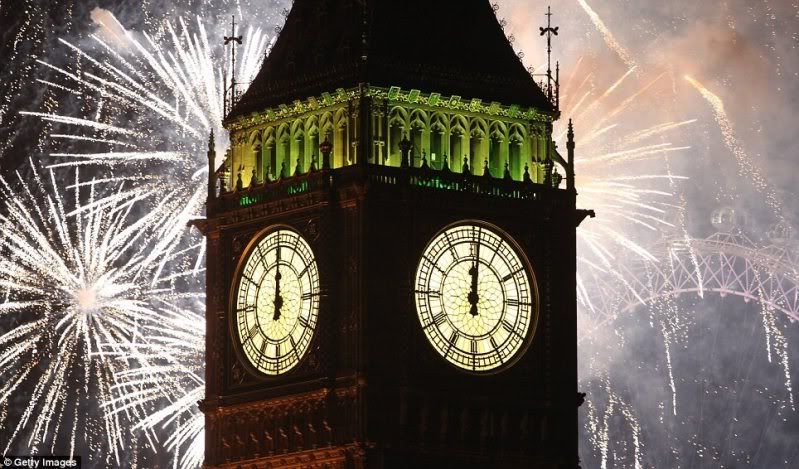
Friday, October 8, 2010
LONDON , my stranger friend
(full screen, pls)
The Hohenzollern Bridge
Photokina in Cologne sits beside the river Rhine and close to one of the city's most striking features. Destroyed in the Second World War as Cologne was flattened by bombing raids, the huge steel bridge was rebuilt after the war and carries pedestrians and trains over the Rhine into Cologne's main station, situated next to the Dom - a spectacular gothic cathedral which survived the fighting - just"
THE BRIDGE
by Andrew Reid, Manchester
Filmmaker and webmaster of EOSHD.com
Thursday, October 7, 2010
10.10.10 - The Christmas of the Amazon
1:43 AM Oct 5th via web in reply to cineandreea "
A very touching and sincere post by Paola from Belém, the capital of Amazonia . Paola is a young Brazilian actress .
http://lardocela.blogspot.com/
SUNday, on 10.10.10 , like "every year, on the second Sunday of October Belem celebrates Cirio de Nazaré, which is considered the biggest catholic manifestation in the world as well as an immaterial cultural heritage of mankind.
People from all over the world come to Belém and unite. At least for these days there is no black or white, no poor or rich. Everybody is one.
If you're afraid to fall, you fall because you're afraid. Everything is choice.
CHOOSE NOT TO FALL is directed by Matthew Marsh and features Daniel Ilabaca, a likeable and talented practitioner of parkour — the urban and physical discipline where athletes train to overcome any obstacle in their path by adapting their movements to the environment. Ilabaca is one of the world’s leading parkour athletes and he is transcendental in his delivery of an articulate and optimistic message against “risk free achievement running rampant in youth culture,” as one juror wrote.
John Ketchum, Filminute’s co-founder and head of jury singled out CHOOSE NOT TO FALL as the most quoted film in the festival, with many references and comments from online voters and Facebook fans repeating Ilabaca’s line “If you’re afraid of falling you fall because you’re afraid.
Danny Ilabaca:
"It's nothing, cause it's everything...
The adventure is not knowing what's going to happen next. Do y'know what I mean, it's accepting that you don't have control, of the future. But all you have control of is now, make the most of now. So every step that I take, is not calculating the fall of. It's just... I, I put my body into that position and I adapt to it.
When you think ahead, in the future, it prevents you from being in the moment now, and when you're in the moment, is when you are... able to do things that other people, y'know, can't understand, or, or put their finger on, y'know?
Y'know, you might not have tomorrow, do y'know what I mean? That's the way I see it, like, I mean... y'know, less time... full on conditioning for the future, and more time just enjoying the fact that you've got another day, really.
Just in, in the world, in general, imaginaton and creativity has just been lost... it's been take- it's been stripped away from us over history, and has been, slowly, fed back into the world that we live in through computer games, and stuff like this! And this is why, y'know, kids are so addicted to, addicted to games, because, y'know, thats a way to achieve, an easy way to achieve. So a lot of people like will be watching, and don't realize, that... I'm really, I'm I'm using my body to really really battle against... obviously, the, the tall physical of this world.
Umm... used to do drugs, used to do all these things, and at one day I saw a guy do a wallflip, in the streets. And, uh, straight away I was drawn in, didn't know why, at the time It was like "Yeah, I want to learn, how to do that."
It, it was that individual,...and the way of... the way he looked at life. And I never knew then, but I, I know now, that's what it was, it was a way, for me to break out of this mold. This uncontrollable system I was in... in order to find truth.
I don't do it to show off, I mean, I do it... maybe to wake someone up, or, to to, y'know, for them to ask the question "Why are you doing this?" and then that, gives me then the opportunity to speak to them and tell them the reason why I do this.
One of my aims is to help people to realize that, y'know, that, parkour is a tool that is so powerful, that it can change so many peoples live, really so... yeah.
I've found, y'know, what I've been looking for through parkour, which is our relationship with God. An-and, I feel that... it's now with that responsibility, that, uh um, position I have in the parkour community, to be that good example, and to pass on the things I've gained over the years, really.
Confidence isn't... isn't gained over time of practice. It's... it's like, confidence is gained when... you realize that you choose your own path? You choose to fall, you choose not to fall.
Just that outlook on life helps me be... more free myself.
Parkour is a tool that can be, used for s-so much good, do y'know what I mean? And for people to become aware of that before it gets to late, and t-to the point where parkour becomes completely physical, it becomes just competition... or, y'know, about making money, and the message is lost."
If you're afraid to fall, you fall because you're afraid. Everything is choice.
